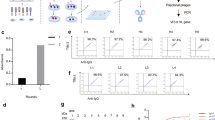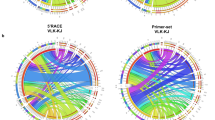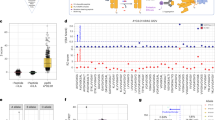Abstract
Ideal gene therapy vectors would be delivered intravenously to transfect only specific cells. Existing vectors only transfect cells in vivo in a manner determined by blood flow and the site of introduction. As a general and systematic approach for generating Cell–targeting ligands for gene therapy vectors, we have used peptide–presenting phage libraries to select peptides that bind and enter several different Cell types. Because of their small size, cell–binding peptides such as these could be incorporated into biological or physical gene therapy vectors. In addition, peptide–presenting phage themselves may also be candidates for gene therapy vectors.
This is a preview of subscription content, access via your institution
Access options
Subscribe to this journal
Receive 12 print issues and online access
$209.00 per year
only $17.42 per issue
Buy this article
- Purchase on Springer Link
- Instant access to full article PDF
Prices may be subject to local taxes which are calculated during checkout
Similar content being viewed by others
References
Mulligan, R.C. The basic science of gene therapy. Science 260, 926–932 (1993).
Feigner, P.L. & Rhodes, G. Gene therapeutics. Nature 349, 351–352 (1991).
Pietersz, G.A. & McKenzie, I.F.C. Antibody conjugates for the treatment of cancer. Immunol. Rev. 129, 57–80 (1992).
Devlin, J.J., Panganiban, L.C. & Devlin, P.E. Random peptide libraries: a source of specific protein binding molecules. Science 249, 404–406 (1990).
Cwirla, S.E., Peters, E.A., Barrett, R.W. & Dower, W.J. Peptides on phage: A vast library of peptides for identifying ligands. Proc. Natl. Acad. Sci. USA 87, 6378–6382 (1990).
Hart, S.L. et al. cell binding and internalization by filamentous phage displaying a cyclic Arg-Gly-Asp-containing peptide. J. Biol. Chem. 269, 12468–12474 (1994).
Doorbar, J. & Winter, G. Isolation of a peptide antagonist to the thrombin receptor using phage display. J. Mol. Biol, 244, 361–369 (1994).
Gotten, M. et al. Transferrin-polycation-mediated introduction of DNA into human leukemic cells: Stimulation by agents that affect the survival of transfected DNA or modulate transferrin receptors. Proc. Natl. Acad. Sci. USA 87, 4033–4037 (1990).
Brown, K.C., Yang, S-H., & Kodadek, T. Highly specific oxidative cross-linking of proteins mediated by a nickel-peptide complex. Biochem. 34, 4733–4739 (1995).
Quantin, B., Perricaudet, L.D., Tajbakhsh, S. & Mandel, J.L. Adenovirus as an expression vector in muscle cells in vivo. Proc. Natl. Acad. Sci. USA 89, 2581–2584 (1992).
Rosenfeld, M.A. et al. Adenovirus-mediated transfer of a recombinant al-antitrypsin gene to the lung epithelium in vivo. Science 252, 431–434 (1991).
Fong, S., Doyle, L.V., Devlin, J.J. & Doyle, M.V. Scanning whole cells with phage-display libraries: Identification of peptide ligands that modulate cell function. Drug Dev. Res. 33, 64–70 (1994).
Hart, S.L. et al. Gene delivery and expression mediated by an integrin-binding peptide. Gene Ther. 2, 552–554 (1995).
Yokoyama-Kobayashi, M. & Kato, S. Recombinant fl phage particles can trans-feet monkey COS-7 cells by DEAE dextran method. Biochem. Biophys. Res. Commun. 192, 935–939 (1993).
Gottschalk, S., Tweten, R.K., Smith, L.C. & Woo, S.L.C. Efficient gene delivery and expression in mammalian cells using DNA coupled with perfringolysin O. Gene Ther. 2, 498–503 (1995).
Markland, W., Roberts, B.L., Saxena, M.J., Guterman, S.K. & Ladner, R.C., Design, construction and function of a multicopy display vector using fusions to the major coat protein of bacteriophage M13. Gene 109, 13–19 (1991).
Jespers, L.S. et al. Surface expression and ligand-based selection of cDNAs fused to filamentous phage gene VI. Bio/Technology 13, 378–382 (1995).
Bassel-Duby, R., Hernandez, M.D., Gonzalez, M.A., Krueger, J.K. & Williams, R.S. A 40-kilodalton protein binds specifically to an upstream sequence element essential for muscle-specific transcription of the human myoglobin promoter. Mol. Cell. Biol. 12, 5024–5032 (1992).
Author information
Authors and Affiliations
Corresponding author
Rights and permissions
About this article
Cite this article
Barry, M., Dower, W. & Johnston, S. Toward cell–targeting gene therapy vectors: Selection of cell–binding peptides from random peptide–presenting phage libraries. Nat Med 2, 299–305 (1996). https://doi.org/10.1038/nm0396-299
Received:
Accepted:
Issue Date:
DOI: https://doi.org/10.1038/nm0396-299
This article is cited by
-
Methods for generating and screening libraries of genetically encoded cyclic peptides in drug discovery
Nature Reviews Chemistry (2020)
-
Improving Molecular Therapy in the Kidney
Molecular Diagnosis & Therapy (2020)
-
Molecular tumor targeting of gelonin by fusion with F3 peptide
Acta Pharmacologica Sinica (2017)
-
Bacteriophages and its applications: an overview
Folia Microbiologica (2017)
-
Advancement and applications of peptide phage display technology in biomedical science
Journal of Biomedical Science (2016)



